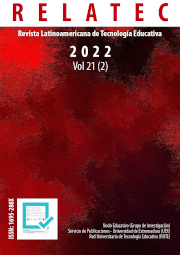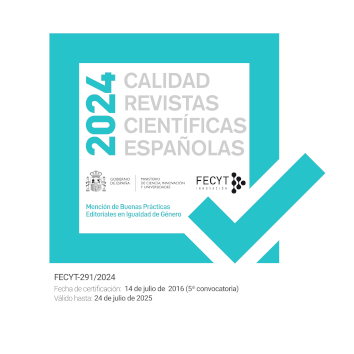FACCE: Framework for assessing cognitive load in online education
DOI:
https://doi.org/10.17398/1695-288X.21.2.111Keywords:
Cognitive load, Instructional design, Evaluation, Distance education, UsabilityAbstract
Analyzing the cognitive load involved in the online teaching and learning process is an important factor in ensuring more concrete educational results, mainly because it observes the interference that different formats of content presentation can cause in the acquisition of information by human memory. With this in mind, this article presents a Framework called FACCE, which is based on aspects arising from the convergence of four studies: the Cognitive Load Theory, the Cognitive Theory of Multimedia Learning, the principles of electronic learning and the Usability Heuristics of Interfaces and search instrumentalize the assessment of cognitive load in online education. This is a qualitative research that addresses the construction and validation of FACCE which was built based on the resources available in HTML5, CSS, Bootstrap Framework, JavaScript and PHP. For data collection in the validation phase of the tool, an adaptation of the SUS System Usability Scale (System Usability Scale) was used, which identifies the quality of the interface of computer systems. The results showed that the proposed Framework has interface quality and therefore can be widely used in the qualification of online teaching from the balance of the cognitive load in the presentation of contents.
Downloads
References
Braum, M. (2019). Como medir a usabilidade de produtos com System Usability Scale (SUS). Disponível em <https://bit.ly/3APs6mY> Acesso em: 14 jun. 2021
Brooke, J. (1996). SUS: A "quick and dirty" usability scale. In P. W. Jordan, B. Thomas, B. A. Weerdmeester, & A. L. McClelland (Eds.), Usability Evaluation in Industry. London: Taylor and Francis. Disponível em https://bit.ly/3DMCptZ
Brooke, J. (2013). SUS: a retrospective. Journal of Usability Studies 8(2), 29-40. Disponível em https://bit.ly/3n1pAFn Carvalho, A. A. A. (2002). Multimídia, um conceito em evolução. Revista Portuguesa de Educação 15(1), 245-268. Disponível em https://goo.gl/ffw69Z
Clark, R.; Nguyen, F.; Sweller, J. (2006). Efficiency in Learning: evidence-based guidelines to manage cognitive load, Wiley.
Cunha, L. M. A. (2007). Modelos Rasch e Escalas de Likert e Thurstone na medição de atitudes. Dissertação. Mestrado em Probabilidades e Estatística. Universidade de Lisboa, Faculdade De Ciências, Departamento de Estatística e Investigação Operacional.
Filatro, A. (2008). Design Instrucional na Prática. Pearson.
Kirschner, Paul A. (2002). Cognitive load theory: implications of cognitive load theory on the design of learning. Learning and Instruction 12. Disponível em https://goo.gl/NYuTVv
Mayer, R. (2002). Multimedia Learning. The Psychology of Learning and Motivation. 41.
Miller, G. A. (1955). The magical number seven, plus or minus two: some limits on our capacity for processing information. Psychological Review, 101(2), pág. 343-352. Disponível em https://goo.gl/vu4R2i
Moore. M.G. The Teory of transaction distance. In MOORE, M. G. (ed.) Handbook of distance education. Mahwah, NJ: Lawrence Erlbaum Associates, 2007. páginas 89-105.
Moran, J. M. Contribuições para uma pedagogia da educação online. In M. Silva, Educação online: teorias, práticas, legislação, formação corporativa (41-52). Editora Loyola.
Nielsen, J. (1994). 10 Usability Heuristics for User Interface Design. Disponível em https://bit.ly/2xMOzXs
Nielsen. J. (2012). Usability 101: Introduction to Usability. Disponível em https://bit.ly/3AJA8xK
Pelli, D.; Rosa, M. (2016). Minimizando a distância transacional: aplicando teorias da educação a distância para mediar a aprendizagem de conteúdos da Geometria plana com a utilização do software GeoGebra na plataforma Moodle. In C. Maciel, K.M. Alonso, M.C. Paniago, Educação a Distância: Interação entre sujeitos, plataformas e recursos. Cuiabá, MT. Editora EduFMT. vol 11. Páginas 23-50.
Santos. E. (2009). Educação Online Para Além Da EAD: Um Fenômeno Da Cibercultura. Anais do X Congresso Internacional Galego-Português de Psicopedagogia. Braga: Universidade do Minho. Páginas 5658-5671. Disponível em: https://bit.ly/2CPFM9h
Sweller, J., & Chandler, P. (1994). Why Some Material Is Difficult to Learn. Cognition and Instruction, 12(3), 185-233. https://doi.org/10.1207/s1532690xci1203_1
Sweller, J., van Merrienboer, J. J. G., & Paas, F. G. W. C. (1998). Cognitive Architecture and Instructional Design. Educational Psychology Review, 10(3), 251-296. https://doi.org/10.1023/A:1022193728205
Downloads
Published
Issue
Section
License
Authors who publish in this journal accept the following conditions:
1. The Author retains copyright in the article. Upon acceptance of the article, the author shall grant to the Publisher the right of first publication of the article. with the dcoument registered with the Creative Commons Attribution-NonCommercial-NoDerivative 4.0 International (CC BY-NC-ND) license, which allows to third parties to use what is published whenever they mention the authorship of the work and the first publication in this journal.
2. Authors can make other independent and additional contractual agreements for the non-exclusive distribution of the article published in this journal (eg, include it in an institutional repository or publish it in a book) provided they clearly indicate that the work was published for the first time in this journal.
3. Authors are allowed and recommended to publish their work on the Internet (for example on institutional or personal pages) before and during the review and publication process, as it can lead to productive exchanges and a greater and faster diffusion of published work (see The Effect of Open Access).









